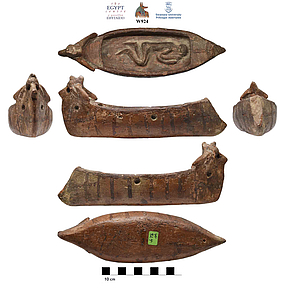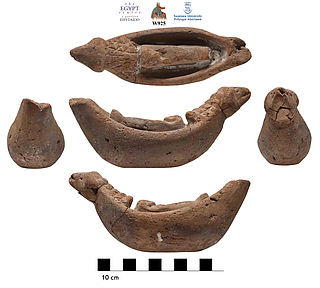Fake – boat model FAK-0013
By Vanhulle, Dorian
Archaeological site unknown
Brussels, Musées royaux d'Art et d'Histoire.
Date : 19th–20th century AD
This model is one of the very few dubious examples to have undergone laboratory analysis to determine its authenticity. The results offer the complete certainty that this object was made within the last 120 years. The most favourable context for its creation is the end of the 19th century and the beginning of the 20th century, so when Predynastic archaeology was at its peak (c. 1890–1930).
Several arguments can be made against the production of models of boat containing a deceased person during the 4th millennium BC in Egypt. Funerary boats do not appear until the pharaonic period, particularly the Middle Kingdom in the context of the development of the Osirian religion. It is at this time that wooden models are developed, of which some are funerary boats loaded with a coffin. During the Predynastic period, the boat is never represented as a vehicle carrying the body of the deceased to the grave. Even in the Old Kingdom, not a single boat is shown carrying a corpse among their numerous representations on mastabas reliefs. They are often simple boats used for hunting and fishing, while in religious iconography, processional boats and well-known solar boats are depicted. Those painted on D-Ware vessels (Naqada IIC–D), which are generally found in tombs, never contain a deceased person, except on a few artefacts that are considered modern, forged decoration applied to genuine ceramics.
Material : Clay
Preservation : Almost complete
Preservation information :
There is a damage (triangular in shape) on the right-hand side, not far from the stern.
Description
It is a relatively massive, well-fired dark reddish-brown terracotta boat model. It represents a flat-bottomed boat. The walls of the hull are straight and only slightly curved. The interior is hollowed out to almost its full height, and a figure is represented inside, moulded into the object. The hands brought to the mouth and the foetal position suggest that it is a deceased. The face, roughly made, is characterised by the presence of two oversized globular eyes. The black pigment (unless it is combustion residue) that marks its contours is still clearly visible.
Earthy concretions appear in the object's rough edges. The bow, which is first oblique and then vertical, is embellished with a decorative element that is difficult to identify. It looks like an elongated face, whose forehead and eyes appear quite clearly. It may imitate the classical "bird's face" of Naqadan figurines and funerary masks. The body could be designated by a thickening of the bow, in the extension of this protome. The edges, located behind the head and marking the junction with the deck, must designate the shoulders. The stern is characterised by the presence of an erect phallus, extending obliquely over the entire extension of the stern. The testicles are shown just above the waterline. The lower end of this decoration, whose allusion to fertility, rebirth and sexual practices is explicit, is slightly detached from the structure.
The upper section of the walls, just below the level of the waterline, is marked by a fairly deep groove probably made by repeated and forceful passages of a pointed tool. A similar groove delimits the central cavity: generally horizontal in front of the bow, it is thicker and curved at the stern. The base of the object is irregular, generally flat, with some roughness that may have resulted from the original shaping of the object. It is also possible that they are the result of progressive wear due to the use of the model. Opposite the largest asperity are four small perforations arranged in a square. These are the marks left by the samples taken for thermoluminescence analysis. Traces of abrasion left by light sandpaper cleaning are visible at their height. This intervention is also a result of modern laboratory operations.
This object belongs to a category of fake antiquities in which also appears the model kept in the Swansea Museum of Egyptian Archaeology. Although the prow of the examplar of Brussels is not decorated with an animal head, their dimensions are similar: the Swansea model is 23 cm long and 6.7 cm wide while the Brussels one is also 23 cm long and 7.7 cm wide. The 7.7 cm of the Brussels model represents the maximum width, which means that these two objects are almost identical in terms of volume. Similarly, they are both made from what appears to be the same dark red clay.The great similarity in the rendering of the deceased body inside the boat and in the manufacture of the central space in which it lays suggest that these two objects were produced by a same workshop/craftman.
Dimensions (cm)
6.3
7.7
23
Additional information
Comments
The model is not listed in the Museum's inventory. It may have been donated, at an unknown date.
Acknowledgements
We thank Dirk Huyge (Royal Museum of Art and History, Brussels) for facilitating the study of this artefact.



















